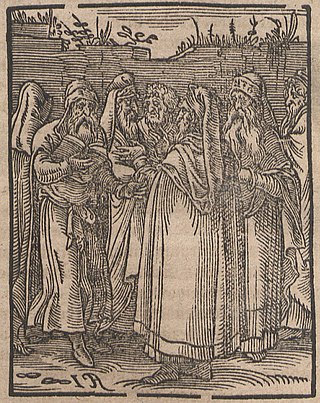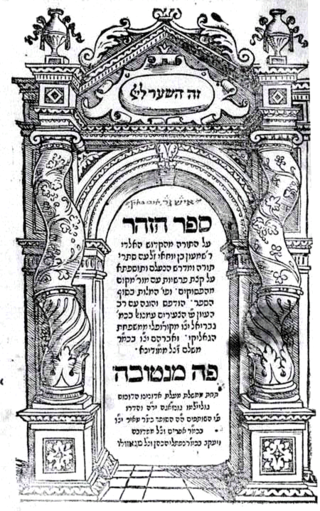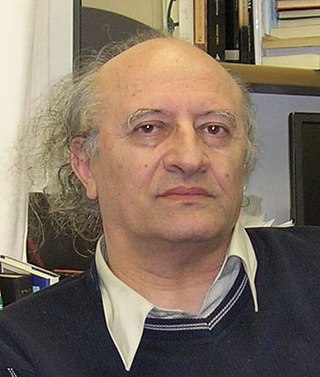Related Research Articles

Kabbalah is an esoteric method, discipline and school of thought in Jewish mysticism. A traditional Kabbalist is called a Mekubbal. The definition of Kabbalah varies according to the tradition and aims of those following it, from its origin in medieval Judaism to its later adaptations in Western esotericism. Jewish Kabbalah is a set of esoteric teachings meant to explain the relationship between the unchanging, eternal God—the mysterious Ein Sof —and the mortal, finite universe. It forms the foundation of mystical religious interpretations within Judaism.

The Zohar is a foundational work in the literature of Jewish mystical thought known as Kabbalah. It is a group of books including commentary on the mystical aspects of the Torah and scriptural interpretations as well as material on mysticism, mythical cosmogony, and mystical psychology. The Zohar contains discussions of the nature of God, the origin and structure of the universe, the nature of souls, redemption, the relationship of Ego to Darkness and "true self" to "The Light of God".

Metatron, or Mattatron, is an angel in Judaism mentioned three times in the Talmud, in a few brief passages in the Aggadah, and in mystical Kabbalistic texts within Rabbinic literature. The figure forms one of the traces for the presence of dualist proclivities in the otherwise monotheistic visions of both the Tanakh and later Christian doctrine. The name Metatron is not mentioned in the Torah or the Bible and how the name originated is a matter of debate. In Islamic tradition, he is also known as Mīṭaṭrūn, the angel of the veil. In folkloristic tradition, he is the highest of the angels and serves as the celestial scribe or "recording angel".

Abraham ben Samuel Abulafia was the founder of the school of "Prophetic Kabbalah". He was born in Zaragoza, Spain in 1240 and is assumed to have died sometime after 1291, following a stay on the small and windswept island of Comino, the smallest of the three inhabited islands that make up the Maltese archipelago.

Merkabah or Merkavahmysticism is a school of early Jewish mysticism, c. 100 BCE – 1000 CE, centered on visions such as those found in the Book of Ezekiel chapter 1, or in the hekhalot literature, concerning stories of ascents to the heavenly palaces and the Throne of God. The main corpus of the merkabah literature was composed in the period 200–700 CE, although later references to the Chariot tradition can also be found in the literature of the Chassidei Ashkenaz in the Middle Ages. A major text in this tradition is the Maaseh Merkabah.
Academic study of Jewish mysticism, especially since Gershom Scholem's Major Trends in Jewish Mysticism (1941), draws distinctions between different forms of mysticism which were practiced in different eras of Jewish history. Of these, Kabbalah, which emerged in 12th-century Europe, is the most well known, but it is not the only typological form, nor was it the first form which emerged. Among the previous forms were Merkabah mysticism, and Ashkenazi Hasidim around the time of the emergence of Kabbalah.
Bahir or Sefer HaBahir is an anonymous mystical work, attributed to a 1st-century rabbinic sage Nehunya ben HaKanah because it begins with the words, "R. Nehunya ben HaKanah said". It is also known as Midrash of Rabbi Nehunya ben HaKanahמִדְרָשׁ רַבִּי נְחוּנְיָא בֶּן הַקָּנָה.

Gershom Scholem, was a German-born Israeli philosopher and historian. Widely regarded as the founder of modern academic study of the Kabbalah, Scholem was appointed the first professor of Jewish mysticism at Hebrew University of Jerusalem.
Ibbur, is one of the transmigration forms of the soul and has similarities with Gilgul neshamot. Ibbur is always good or positive, while dybbuk, is negative. Ibbur is the most positive form of possession, and the most complicated. It happens when a righteous soul decides to occupy a living person's body for a time, and joins, or spiritually "impregnates" the existing soul. Ibbur is always temporary, and the living person may or may not know that it has taken place. Often the living person has graciously given consent for the Ibbur. The reason for Ibbur is always benevolent—the departed soul wishes to complete an important task, to fulfil a promise, or to perform a mitzvah that can only be accomplished in the flesh. In Lurianic Kabbalah, ibbur occurs when an incomplete soul which cannot achieve tikun is completed by the addition of the soul of a tzadik, or spiritual master. Luria believed this to be possible even whilst the possessor was still alive.

The Hasidim of Ashkenaz were a Jewish mystical, ascetic movement in the German Rhineland during the 12th and 13th centuries.
The Hekhalot literature from the Hebrew word for "Palaces", relating to visions of ascents into heavenly palaces. The genre overlaps with Merkabah or "Chariot" literature, concerning Ezekiel's chariot, so the two are sometimes referred to together as "Books of the Palaces and the Chariot". The Hekhalot literature is a genre of Jewish esoteric and revelatory texts produced some time between late antiquity – some believe from Talmudic times or earlier – to the Early Middle Ages.

Rachel Elior is an Israeli professor of Jewish philosophy at the Hebrew University of Jerusalem in Jerusalem, Israel. Her principal subjects of research has been Hasidism and the history of early Jewish mysticism.
The primary texts of Kabbalah were allegedly once part of an ongoing oral tradition. The written texts are obscure and difficult for readers who are unfamiliar with Jewish spirituality which assumes extensive knowledge of the Tanakh, Midrash and halakha.
Moshe ben Chasdai Taku was a 13th-century Tosafist from Tachov, Bohemia. Despite his own seemingly mystical orientation, Rabbi Taku is controversially known to have been an opponent of both the esoteric theology of the Chassidei Ashkenaz and the philosophical orientation of rabbinic rationalists such as Saadia Gaon, Maimonides, Abraham ibn Ezra et al. He believed that both trends were a deviant departure from traditional Judaism, which he understood to espouse a literal perspective of both the biblical narrative, and the Aggadata of the Sages. His opposition to all theological speculation earned him, in the opinion of Gershon Scholem, the title of one of the two truly reactionary Jewish writers of the Middle Ages.
Sefer HaTemunah is a 13–14th century kabbalistic text. It is quoted in many Halakhic sources.
Jonathan Garb is an Israeli scholar of Kabbalah. He is Holder of the Gershom Scholem chair in Kabbalah in the Department of Jewish Thought at the Hebrew University of Jerusalem.

Boaz Huss is a professor of Kabbalah at the Goldstein-Goren Department of Jewish Thought at Ben-Gurion University of the Negev. He is a leading scholar in contemporary Kabbalah.

Moshe Idel is a Romanian-Israeli historian and philosopher of Jewish mysticism. He is Emeritus Max Cooper Professor in Jewish Thought at the Hebrew University, Jerusalem, and a Senior Researcher at the Shalom Hartman Institute.

Yehuda Liebes is an Israeli academic and scholar. He is the Gershom Scholem Professor Emeritus of Kabbalah at the Hebrew University of Jerusalem. He is considered a leading scholar of Kabbalah; his other research interests include Jewish myth, Sabbateanism, and the links between Judaism and ancient Greek religion, Christianity, and Islam. He is the recipient of the 1997 Bialik Prize, the 1999 Gershom Scholem Prize for Kabbalah Research, the 2006 EMET Prize for Art, Science and Culture, and the 2017 Israel Prize in Jewish thought.
References
- ↑ Huss, Boaz, and Joel A. Linsider. "Ask No Questions: Gershom Scholem and the Study of Contemporary Jewish Mysticism." Modern Judaism 25, no. 2 (2005): 141–158.
- ↑ Huss, Boaz. "'Authorized Guardians': The Polemics of Academic Scholars of Jewish Mysticism against Kabbalah Practitioners." Polemical Encounters: Esoteric Discourse and its Others, Leiden & Boston: Brill (2007): 104–126.
- 1 2 Baumgardt, David. "Major Trends in Jewish Mysticism, by Gershom G. Scholem." Commentary Magazine. July 1, 1947.
- ↑ Wasserstrom, Steven M. "Sefer Yesira and early Islam: A reappraisal." The Journal of Jewish Thought and Philosophy 3, no. 1 (1994): 1–30.
- ↑ Schäfer, Peter, and Joseph Dan, eds. Gershom Scholem's Major Trends in Jewish Mysticism 50 Years After: Proceedings of the Sixth International Conference on the History of Jewish Mysticism. Mohr Siebeck, 1993.